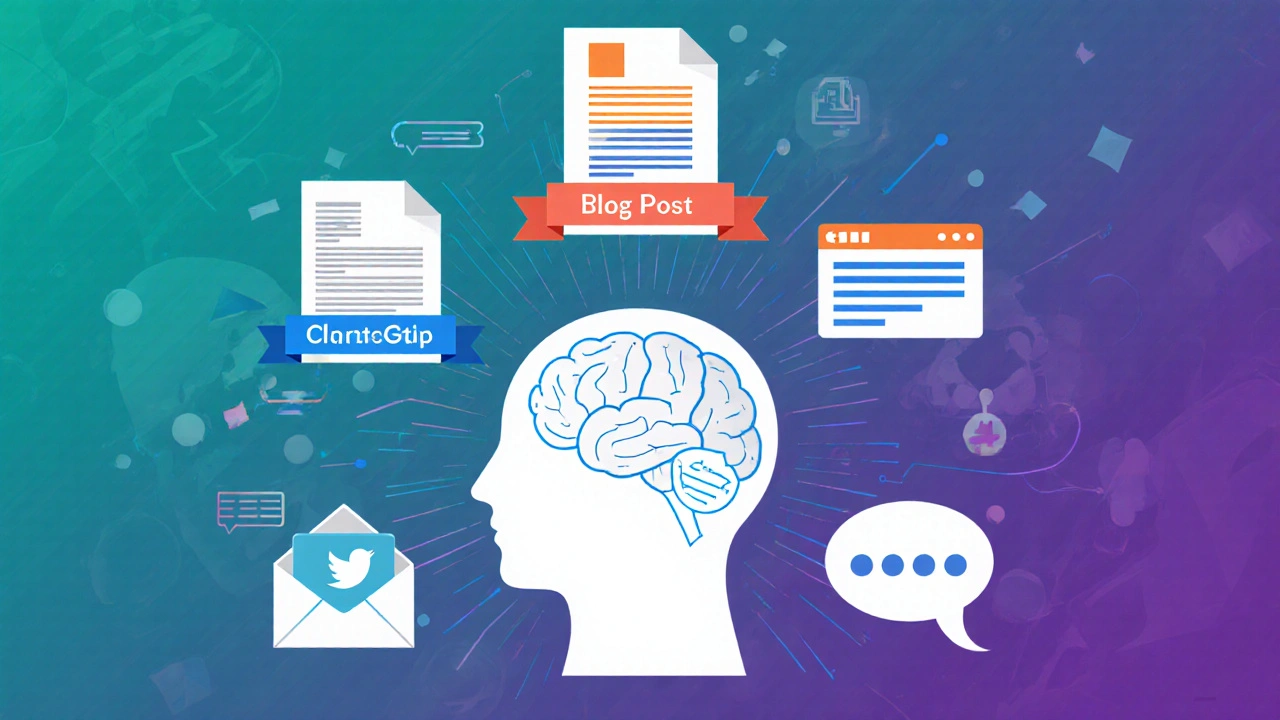ChatGPT for Online Marketing: How It Works & Why It Matters

ChatGPT Prompt Generator
Example Prompt
You are a senior copywriter for a tech startup. Write a 150-word blog post about 'The Future of AI in Marketing' in a friendly tone for busy professionals aged 25-40. Focus on practical applications and include SEO keywords like 'AI marketing', 'marketing automation', and 'future trends'.
Your Generated Prompt
TL;DR
- ChatGPT can write, optimize and personalize every piece of online marketing material.
- It works by predicting the next word in a sentence, guided by your prompts.
- Key uses include blog posts, SEO meta tags, ad copy, email sequences, social posts and chatbots.
- Good prompts + human review give faster output, higher conversion rates and lower content costs.
- Start simple, test results, then scale with the OpenAI API or integrated SaaS tools.
When marketers hear ChatGPT for online marketing, they expect a magic button that writes perfect copy. The reality is a bit more nuanced, but the payoff is real. Below we break down how the model works, the concrete ways it fits into a digital‑marketing workflow, and the steps you need to take to get measurable results.
What is ChatGPT and how does it work?
ChatGPT is a conversational AI language model developed by OpenAI that generates human‑like text based on the prompts it receives. At its core the model predicts the most likely next word in a sequence, using patterns learned from billions of web pages, books and code snippets. When you give it a prompt like “Write a 150‑word Instagram caption for a new coffee blend,” it draws on those patterns to produce a coherent, brand‑friendly piece of copy.
The model runs on a transformer architecture, which lets it keep context over long passages. That means you can ask it to draft a blog outline, then follow up with “Expand section2 into a full article” and it will stay on topic.
Key Online Marketing Areas Where ChatGPT Shines
Below are the top marketing tasks where the AI adds real value. Each headline includes a short definition with microdata for future reference.
Content generation is the creation of written or visual assets such as blog posts, landing‑page copy, social updates and video scripts. ChatGPT can draft first drafts in seconds, freeing writers to focus on strategy and brand voice.
- Blog outlines in under a minute.
- Long‑form articles with SEO‑friendly headings.
- Video script teasers for YouTube or TikTok.
SEO refers to the practice of optimizing web content so that search engines rank it higher for relevant queries. The AI can suggest keyword‑rich titles, meta descriptions, and even suggest internal link structures.
- Generate 160‑character meta tags that include target keywords.
- Produce FAQ snippets that Google loves.
Ad copy means short, persuasive text used in paid channels like Google Ads, Facebook and LinkedIn. By feeding performance data, you can ask ChatGPT to rewrite headlines for higher click‑through rates.
- 80‑character headlines that meet character limits.
- Multiple variations for A/B testing.
Email marketing involves sending targeted messages to a list of subscribers to nurture leads or drive sales. The AI can craft welcome series, re‑engagement emails, and product‑launch sequences in a few clicks.
- Personalized subject lines based on subscriber data.
- Body copy that balances storytelling and call‑to‑action.
Social media posts are short updates, tweets or carousel captions designed to spark engagement on platforms like Instagram, LinkedIn or TikTok. ChatGPT can adapt tone for each channel, suggest hashtags, and even generate image alt‑text.
- 30‑character tweets with trending hashtags.
- Instagram carousel copy that tells a story in 4 slides.
Chatbots & customer support are automated conversational interfaces that handle routine queries and guide users toward conversion. By feeding your FAQ database, ChatGPT can power a 24/7 support bot that sounds natural.
- Answer common product questions instantly.
- Collect leads by asking for email before escalation.
Prompt Engineering: Getting the Most Out of ChatGPT
The difference between a generic paragraph and a conversion‑ready piece often lies in how you ask. Here are three proven prompt patterns:
- Role‑play prompt: “You are a senior copywriter for a luxury skincare brand. Write a 100‑word product description that emphasizes anti‑age benefits.”
- Structure prompt: “Create a blog outline about ‘AI trends in e‑commerce’ with five headings and a short bullet under each.”
- Data‑driven prompt: “Based on a 30% open‑rate and 2% click‑rate, rewrite this email subject line to improve engagement.”
Start with a clear goal, supply any necessary context (brand voice, target audience, performance metrics), and tell the model the format you want. The result is more accurate and saves you editing time.

Why It Matters: Benefits & ROI
Managers often ask for hard numbers. Here’s a quick snapshot drawn from recent case studies (2024‑2025):
- Production speed: Teams report a 70% reduction in time to publish blog posts.
- Cost efficiency: Content budgets shrink by up to 40% when AI handles first drafts.
- Conversion lift: Personalized email subject lines generated by ChatGPT improve click‑through rates by an average of 15%.
- SEO gains: AI‑crafted meta descriptions increase organic click‑through by 12% within weeks.
These gains stack. Faster turnaround means you can test more ideas, and higher conversion translates directly to revenue.
Common Pitfalls and How to Avoid Them
Even the smartest tool can backfire if you don’t set guardrails.
- Hallucinated facts: ChatGPT can invent statistics. Always verify numbers against trusted sources.
- Brand inconsistency: Without a style guide, the tone may drift. Include “tone: friendly, professional” in every prompt.
- Over‑reliance on AI: Use the model for drafts, not final legal copy. Human review catches compliance issues.
- Prompt fatigue: Re‑using the same prompt yields similar output. Rotate phrasing or add fresh context.
Implement a simple workflow: AI draft → human edit → A/B test → analytics feedback → prompt tweak. This loop ensures quality while preserving speed.
Choosing the Right Toolset
You can interact with ChatGPT directly on the OpenAI site, but most marketers integrate the model into existing stacks.
| Option | Key Features | Typical Cost (2025) | Best For |
|---|---|---|---|
| ChatGPT Plus (web UI) | Priority access, faster response, 100K tokens/month | $20/month | Solo freelancers, small teams testing concepts |
| OpenAI API (gpt‑4‑turbo) | Programmable, scalable, pay‑as‑you‑go | $0.003 per 1K tokens | Tech‑savvy teams building custom workflows |
| AI‑powered SaaS (e.g., Jasper, Copy.ai) | Templates, collaboration UI, brand‑tone manager | $49-$199/month | Marketing agencies, content teams needing UI |
| CRM/Email plugins (e.g., HubSpot AI writer) | Direct embed in email builders, auto‑personalization | Included in higher‑tier plans | Marketers focused on email & automation |
Start with the free tier to experiment, then graduate to an API or SaaS platform once you have a repeatable process.
Getting Started Checklist
- Define the marketing goal (traffic, leads, sales).
- Choose a prompt style that matches the goal.
- Select an integration option (Plus, API, SaaS).
- Draft the first piece of copy with the model.
- Run a quick human edit for brand voice & factual accuracy.
- Publish and track performance metrics (CTR, conversion, SEO rank).
- Feed results back into the next prompt for continuous improvement.
Follow these steps and you’ll move from “AI curiosity” to measurable marketing impact in weeks, not months.
Frequently Asked Questions
Can ChatGPT replace a human copywriter?
No. It’s a speed‑boost tool that drafts ideas. Human writers still add brand nuance, legal compliance and creative flair that the model can’t guarantee.
Is the content generated by ChatGPT SEO‑friendly?
Yes, if you tell the model to include target keywords, meta tags and structured headings. Always run the output through an SEO audit tool before publishing.
How much does using the OpenAI API cost for a typical blog post?
A 1,200‑word article uses roughly 2,000 tokens. At $0.003 per 1K tokens, the cost is about $0.006 - essentially pennies per post.
What are the biggest risks of using AI‑generated copy?
Hallucinated facts, brand‑voice drift, and potential copyright issues if you reuse training data snippets. Mitigate with fact‑checking, style guides, and a human sign‑off.
Can I use ChatGPT for multilingual campaigns?
Absolutely. The model supports dozens of languages. Provide prompts in the target language and specify cultural nuances for best results.



